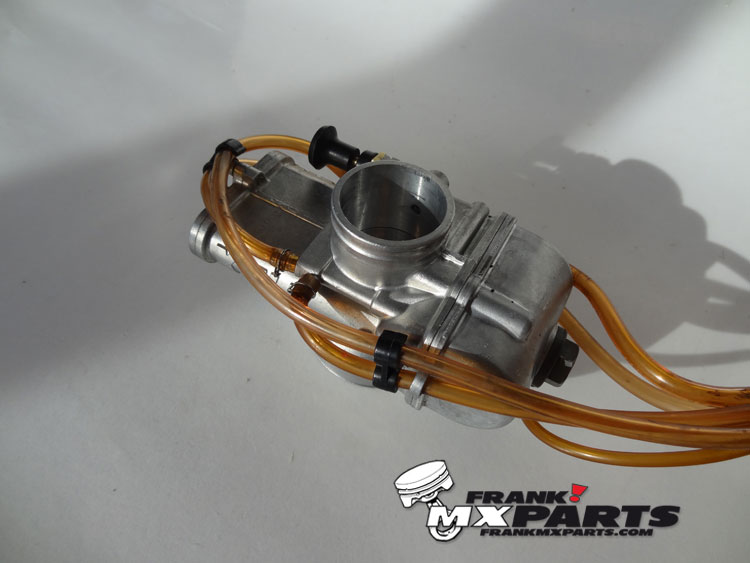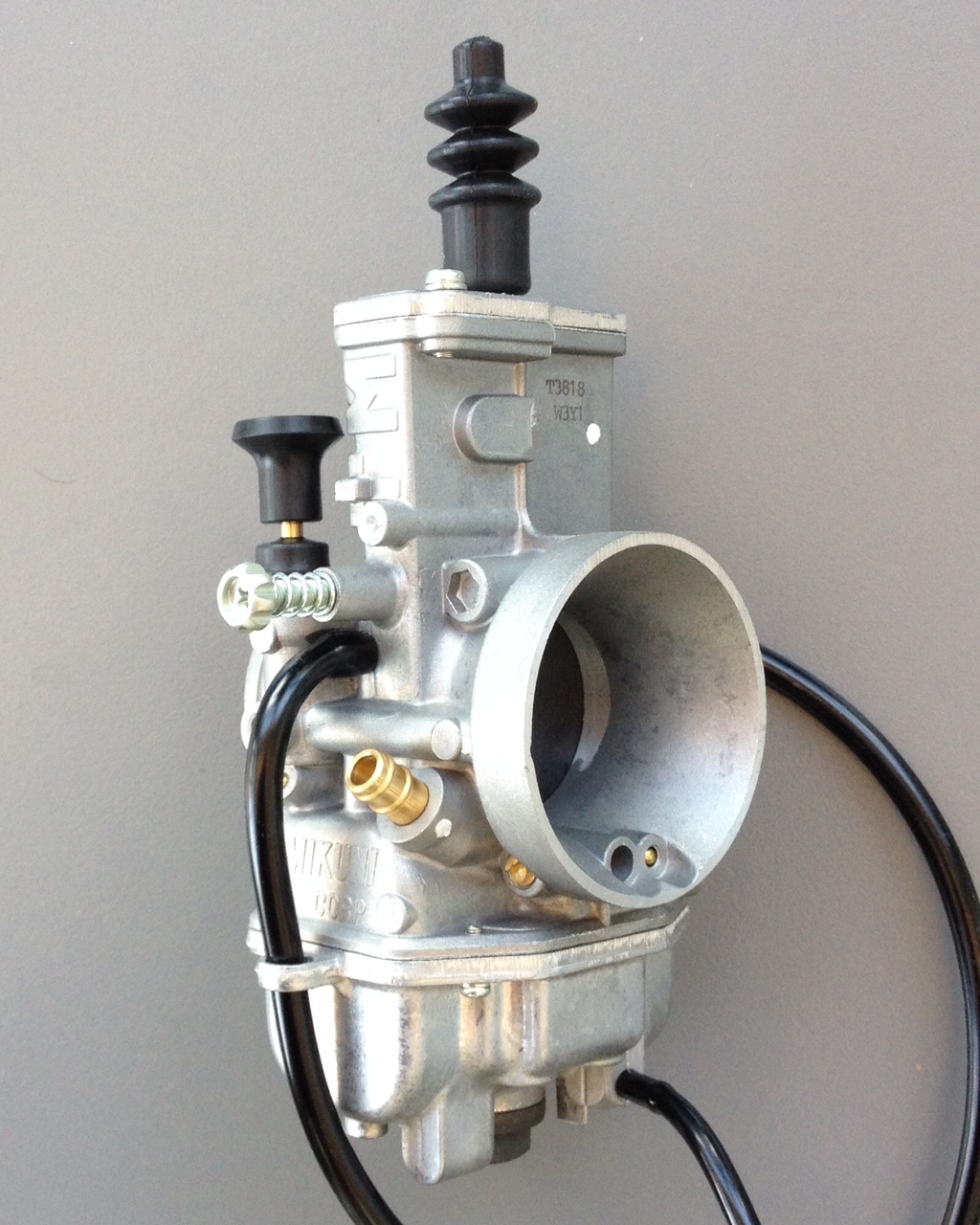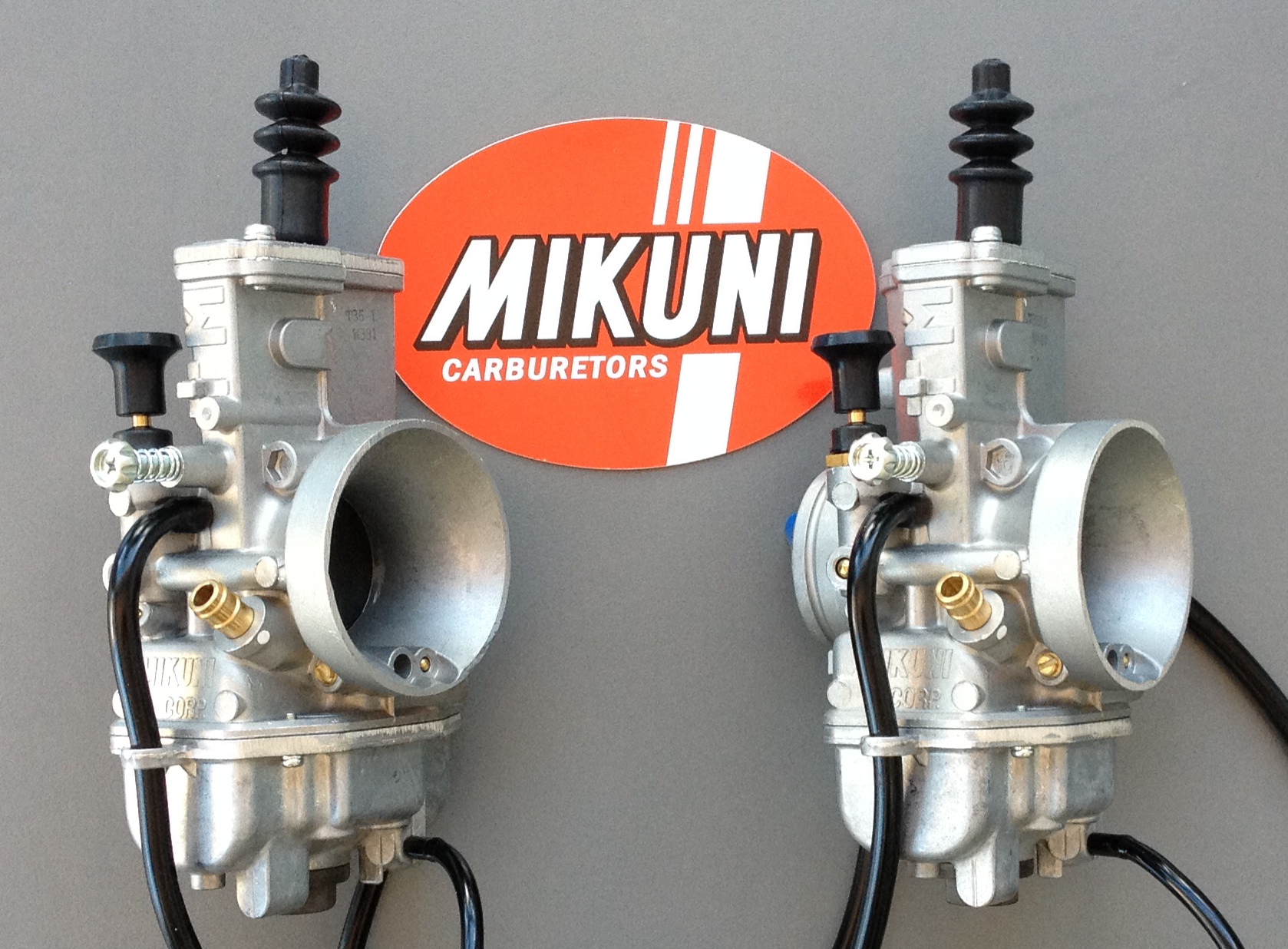Mikuni Tmx 38 Carburetor Manual
- Mikuni Tmx 38 Tuning
- Mikuni Tm38 Manual
- Mikuni Tmx 38 Manual
- Mikuni 34mm Carburetor Manual
- Mikuni Carburetor Manual
- Mikuni Tmx Parts
Mikuni Motorcycle Carburetor Theory 101
Motorcycle carburetors look very complex, but with a little theory, you can tune your bike for maximum performance. All carburetors work under the basic principle of atmospheric pressure. Atmospheric pressure is a powerful force which exerts pressure on everything. It varies slightly but is generally considered to be 15 pounds per square inch (PSI). This means that atmospheric pressure is pressing on everything at 15 PSI. By varying the atmospheric pressure inside the engine and carburetor, we can change the pressure and make fuel and air flow.
Atmospheric pressure will force high pressure to low pressure. As the piston on a two stroke engine goes up (or goes down on a four stroke engine), a low pressure is formed inside the crankcase (above the piston on a four stroke). This low pressure also causes a low pressure inside the carburetor. Since the pressure is higher outside the engine and carburetor, air will rush inside the carburetor and engine until the pressure is equalized. The moving air going through the carburetor will pick up fuel and mix with the air.
Inside a carburetor is a venturi, fig 1. The venturi is a restriction inside the carburetor that forces air to speed up to get through. A river that suddenly narrows can be used to illustrate what happens inside a carb. The water in the river speeds up as it gets near the narrowed shores and will get faster if the river narrows even more. The same thing happens inside the carburetor. The air that is speeding up will cause atmospheric pressure to drop inside the carburetor. The faster the air moves, the lower the pressure inside the carburetor.
Mikuni Tmx 38 Tuning
Don't spend hundreds on a Lectron carb!!! I will show you how to get your Mikuni TMX carb working amazing for only $25!!! My 2003 CR250 has never ran or soun.
FIG 1
Most motorcycle carburetor circuits are governed by throttle position and not by engine speed.There are five main metering systems inside most motorcycle carburetors. These metering circuits overlap each other and they are:
* pilot circuit
* throttle valve
* needle jet and jet needle
* main jet
* choke circuit
The pilot circuit has two adjustable parts, fig 2. The pilot air screw and pilot jet. The air screw can be located either near the back side of the carburetor or near the front of the carburetor. If the screw is located near the back, it regulates how much air enters the circuit. If the screw is turned in, it reduces the amount of air and richens the mixture. If it is turned out, it opens the passage more and allows more air into the circuit which results in a lean mixture. If the screw is located near the front, it regulated fuel. The mixture will be leaner if it is screwed in and richer if screwed out. If the air screw has to be turned more than 2 turns out for best idling, the next smaller size pilot jet will be needed.
- Mikuni TMX 38 flatslide carburetor / TM38-27. Manual camshaft chain tensioner KTM EXC SXF SMR 250 350 450 550 2006-2015. Created Date: 1/12/2001 11:14:38 AM. Convert 1080p to 4k software. Mikuni Carburetor Manuals This page lists our Carburetor Owner's and Tuning Manuals. Download and read or print these documents by clicking on the titles below.
- New Style TM 38 Carburetor, with Side Idle Adjuster Screw TM38 (TM38-85), TM38 (TM38-86). Works on Keihin and Mikuni carburetor caps. The kit 007-731 contains: 002.
- Sudco International Corp. Sequoia Drive Compton, CA 90220. Tel.(310) 637-8330. Fax (310) 637-8331 Email: sudco@sudco.com Quick Links. Dealer's Application.
FIG 2
Bosch s7 drill stand manual user. The pilot jet is the part which supplies most of the fuel at low throttle openings. It has a small hole in it which restricts fuel flow though it. Both the pilot air screw and pilot jet affects carburetion from idle to around 1/4 throttle.


The slide valve affects carburetion between 1/8 thru 1/2 throttle. It especially affects it between 1/8 and 1/4 and has a lesser affect up to 1/2. The slides come in various sizes and the size is determined by how much is cutaway from the backside of it, fig 3. The larger the cutaway, the leaner the mixture (since more air is allowed through it) and the smaller the cutaway, the richer the mixture will be. Throttle valves have numbers on them that explains how much the cutaway is. If there is a 3 stamped into the slide, it has a 3.0mm cutaway, while a 1 will have a 1.0mm cutaway (which will be richer than a 3).
FIG 3
The jet needle and needle jet affects carburetion from 1/4 thru 3/4 throttle. The jet needle is a long tapered rod that controls how much fuel can be drawn into the carburetor venturi. The thinner the taper, the richer the mixture. The thicker the taper, the leaner the mixture since the thicker taper will not allow as much fuel into the venturi as a leaner one. The tapers are designed very precisely to give different mixtures at different throttle openings. Jet needles have grooves cut into the top. A clip goes into one of these grooves and holds it from falling or moving from the slide. The clip position can be changed to make an engine run richer or leaner, fig 4. If the engine needs to run leaner, the clip would be moved higher. This will drop the needle farther down into the needle jet and cause less fuel to flow past it. If the clip is lowered, the jet needle is raised and the mixture will be richer.
The needle jet is where the jet needle slides into. Depending on the inside diameter of the needle jet, it will affect the jet needle. The needle jet and jet needle work together to control the fuel flow between the 1/8 thru 3/4 range. Most of the tuning for this range is done to the jet needle, and not the needle jet.
FIG 4
The main jet controls fuel flow from 3/4 thru full throttle, fig 5. Once the throttle is opened far enough, the jet needle is pulled high enough out of the needle jet and the size of the hole in the main jet begins to regulate fuel flow. Main jets have different size holes in them and the bigger the hole, the more fuel that will flow (and the richer the mixture). The higher the number on the main jet, the more fuel that can flow through it and the richer the mixture.
FIG 5
Mikuni Tm38 Manual
The choke system is used to start cold engines. Since the fuel in a cold engine is sticking to the cylinder walls due to condensation, the mixture is too lean for the engine to start. The choke system will add fuel to the engine to compensate for the fuel that is stuck to the cylinder walls. Once the engine is warmed up, condensation is not a problem, and the choke is not needed.
The air/fuel mixture must be changes to meet the demands of the needs of the engine. The ideal air/fuel ratio is 14.7 grams of air to 1 gram of fuel. This ideal ratio is only achieved for a very short period while the engine is running. Due to the incomplete vaporization of fuel at slow speeds or the additional fuel required at high speeds, the actual operational air/fuel ratio is usually richer. Figure 6 shows the actual air/fuel ratio for any given throttle opening.
FIG 6

Carburetor Jetting Troubleshooting
Carburetor troubleshooting is simple once the basic principles are known. The first step is to find where the engine is running poorly, fig 7. It must be remembered that carburetor jetting is determined by the throttle position, not engine speed. If the engine is having troubles at low rpm (idle to 1/4 throttle), the pilot system or slide valve is the likely problem. If the engine has problems between 1/4 and 3/4 throttle, the jet needle and needle jet (most likely the jet needle) is likely the problem. If the engine is running poorly at 3/4 to full throttle, the main jet is the likely problem.
FIG 7
While jetting carburetors, place a piece of tape on the throttle housing. Place another piece of tape on the throttle grip and draw a line (while the throttle is at idle) straight across from one piece of tape to the other. When these two lines are lined up, the engine will be idling. Now open the throttle to full throttle and draw another line directly across from it on the throttle housing. At this point, there should be two lines on the throttle housing, and one on the throttle grip. Now find the half-way point between both of the lines on the throttle housing. Make a mark and this will show when the throttle is at half throttle. Divide the spaces up even again until idle, 1/4, 1/2, 3/4, and full throttle positions are known. These lines will be used to quickly find the exact throttle opening while jetting.

Clean the air filter and warm the bike up. Accelerate through the gears until the throttle is at full throttle (a slight uphill is the best place for this). After a few seconds of full throttle running, quickly pull in the clutch and stop the engine (Do not allow the engine to idle or coast to a stop). Remove the spark plug and look at its color. It should be a light tan color (for more info on reading spark plugs click here). If it's white, the air/fuel mixture is too lean and a bigger main jet will have to be installed. If it's black or dark brown, the air/fuel mixture is too rich and a smaller main jet will have to be installed. While changing jets, change them one size at a time, test run after each change, and look at the plug color after each run.

After the main jet has been set, run the bike at half throttle and check the plug color. If it's white, lower the clip on the jet needle to richen the air/fuel mixture. If it's dark brown or black, raise the clip to lean the air/fuel mixture.
The pilot circuit can be adjusted while the bike is idling and then test run. If the engine is running poorly just off of idle, the pilot jet screw can be turned in or out to change the air-fuel mixture. If the screw is in the back of the carburetor, screwing it out will lean the mixture while screwing it in will richen it. If the adjustment screw is in the front of the carburetor, it will be the opposite. If turning the screw between one and two and a half doesn't have any affect, the pilot jet will have to be replaced with either a larger or smaller one. While adjusting the pilot screw, turn it 1/4 turn at a time and test run the bike between adjustments. Adjust the pilot circuit until the motorcycle runs cleanly off of idle with no hesitations or bogs.
Altitude, Humidy, and Air Temperature
Once the jetting is set and the bike is running good, there are many factors that will change the performane of the engine. Altitude, air temperature, and humidity are big factors that will affect how an engine will run. Air density increases as air gets colder. This means that there are more oxygen molecules in the same space when the air is cold. When the temperature drops, the engine will run leaner and more fuel will have to be added to compensate. When the air temperature gets warmer, the engine will run richer and less fuel will be needed. An engine that is jetted at 32deg Fahrenheit may run poorly when the temperature reaches 90deg Fahrenheit.
Altitude affects jetting since there are less air molecules as altitude increases. A bike that runs good at sea level will run rich at 10,000 ft due to the thinner air.
Mikuni Tmx 38 Manual
Humidity is how much moister is in the air. As humidity increases, jetting will be richer. A bike that runs fins in the mornings dry air may run rich as the day goes on and the humidity increases.
Correction factors are sometimes used to find the correct carburetor settings for changing temperatures and altitudes. The chart in fig 8, shows a typical correction factor chart. To use this chart, jet the carburetor and write down the pilot and main jet sizes. Determine the correct air temperature and follow the chart over to the right until the correct elevation is found. Move straight down from this point until the correct correction factor is found. Using fig 8 as an example, the air temperature is 95deg Fahrenheit and the altitude is 3200 ft. The correction factor will be 0.92. To find out the correction main and pilot jets, multiple the correction factor and each jet size. A main jet size of 350 would be multiplied by 0.92 and the new main jet size would be a 322. A pilot jet size of 40 would be multiplied by 0.92 and the pilot jet size would be 36.8.
FIG 8
Correction factors can also be used to find the correct settings for the needle jet, jet needle, and air screw. Use the chart from fig 9 and determine the correction factor. Then use the table below to determine what to do with the needle jet, jet needle, and air screw.
Needle Jet/Jet Needle/Air Screw Correction Chart |
Correction factor | 1.04 or above | 1.04-1.00 | 1.00-0.96 | 0.96-0.92 | 0.92 or below |
Needle jet | Two sizes larger | One size larger | Same size | One size smaller | Two sizes smaller |
Jet needle setting | Lower clip position | Same | Same | Same | Raise clip one position |
Air screw opening | One turn in | 1/2 turn in | Same | 1/2 turn out | One turn out |
Mikuni 34mm Carburetor Manual
FIG 9
This article was written by, and has been reprinted with the permission of Doug Jenks. All rights reserved.
smallengprep@yahoo.com
Mikuni Carburetor Manual
Back to page.
Free Niv Bible Download Niv Audio Bible Free Download For Mobile Easyworship Crack provides full access to create Bibles, worship lyrics, and background multimedia files Bring the easyworship bibles free download beauty easyworship bibles free download and truth of the Bible into everyday life. Get all the bible plug-ins you need for your EasyWorship church presentation software in multiple versions and language translations. Prepare your sermon notes for your next mission trip, worship service or weekly church service. Easy worship bibles rar niv free.